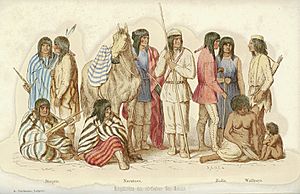Battle of Pecos River facts for kids
Quick facts for kids Battle of Pecos River |
|||||||
|---|---|---|---|---|---|---|---|
| Part of the Navajo Wars | |||||||
 "The indigenous people of northern New Mexico" by Balduin Möllhausen, 1861. |
|||||||
|
|||||||
| Belligerents | |||||||
| Navajo | |||||||
| Commanders and leaders | |||||||
| unknown | |||||||
| Strength | |||||||
| 15 cavalry ~10 infantry ~60 native scouts |
~100 warriors | ||||||
| Casualties and losses | |||||||
| None | 40 killed 25 wounded |
||||||
The Battle of Pecos River happened in 1864 during the Navajo Wars. This was a time when the United States Army had many conflicts with Native American tribes. In this battle, soldiers from the U.S. Army and Apache Scouts fought against Navajo warriors. The fight took place near the Pecos River in New Mexico. The U.S. forces won this battle. It's also known as one of the battles involving the California Column. The California Column was a group of Union Army soldiers from California.
The Battle Begins
The battle started when Navajo warriors took many mules and horses. They had raided a place called the Bosque Redondo reservation. An Indian Agent named Lorenzo Labadie led a group of about sixty Mescalero Apache scouts. They were joined by Chief Cadete. This group began to track the Navajo warriors, who numbered around 100. They followed them south along the Pecos River.
The Navajo realized they couldn't get away with the stolen animals. So, they decided to stop and fight. They found good spots along the river to wait for their pursuers. By this time, more soldiers had arrived to help Labadie's group. There were fifteen soldiers from the 2nd California Cavalry. Also, at least ten men from the 5th Infantry joined them. These soldiers were led by Lieutenant Charles Newbold.
A Cold Winter Fight
It was about 11:00 AM on January 4, 1864. The weather was extremely cold, around ten degrees below zero. The American and Apache forces found the Navajo waiting in a small valley. The Navajo opened fire when the Americans were about eighty yards away. The U.S. soldiers and Apache scouts quickly found cover and began shooting back.
Lieutenant Newbold then gave an order for his soldiers to charge forward. They used their revolvers in the attack. Newbold later described this charge as going "down like a small tornado". During this first attack, nine Navajo warriors were killed.
Fighting Continues
After the charge, smaller fights continued for several hours. The battle lasted all day until the sun went down. Much of the fighting happened from a distance. This made it hard for both sides to see each other clearly. The very cold winter weather also caused problems. Soldiers and scouts suffered from frostbite. This made it harder for them to reload their weapons quickly.
Because of the cold, the Apache scouts eventually stopped using their rifles. Instead, they used bows and arrows. The American soldiers each carried two Colt six-shooters.
Battle's End
The fighting finally ended when the Navajo warriors fled. The soldiers estimated that about forty Navajo warriors were killed on the battlefield. At least twenty-five others were wounded. They also reported that around twenty-five more managed to escape.
Despite the long and tough fight, not a single American soldier or Apache scout was wounded. Fifty horses and mules that had been stolen were recovered. Less than two weeks after this battle, Colonel Kit Carson led American troops in another important fight. This was the Fall of Canyon de Chelly. That battle eventually led to the Long Walk to Fort Sumner.

